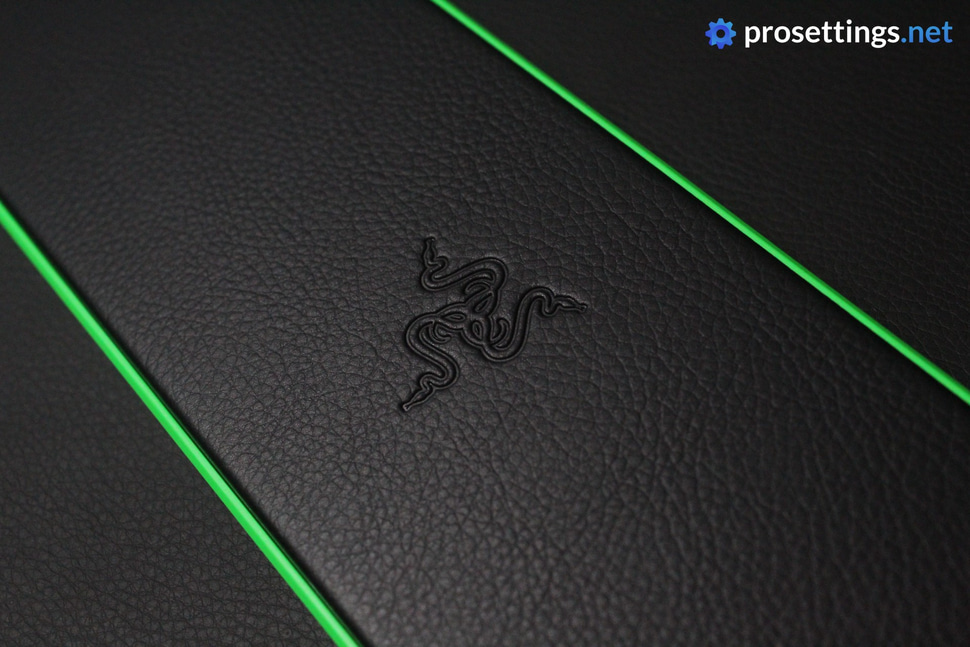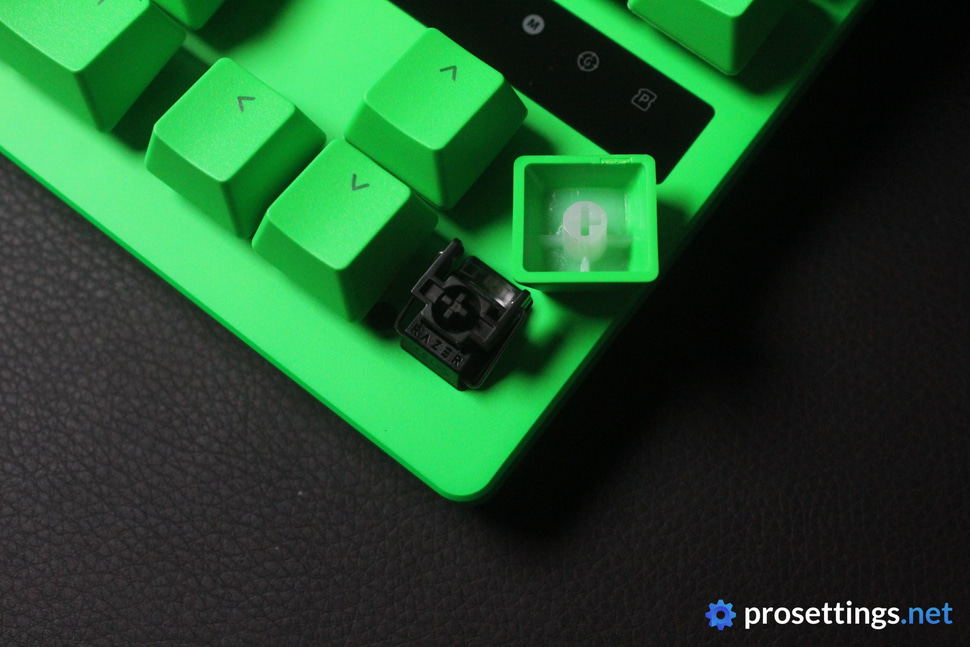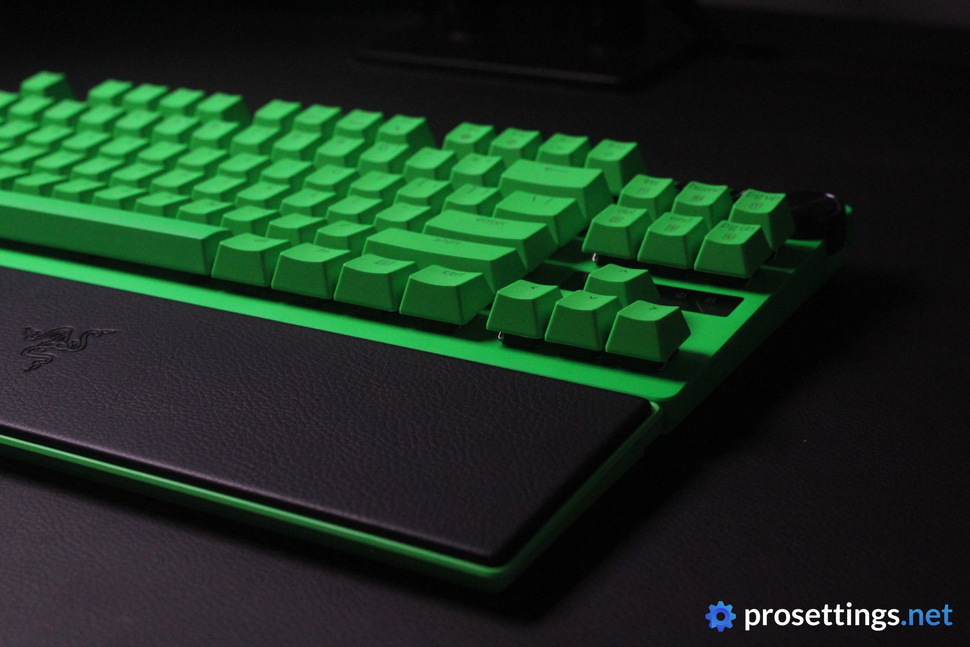Introduction
Razer’s Huntsman V3 Pro TKL keyboard is an industry staple. It’s used by tons of professional gamers and it was, at one point, the most used gaming keyboard on the entire website. With those credentials, it’s only logical that any new addition to this lineup would receive lots of attention, and here we are now. This 8KHz version might not be a true successor (it’s more of an iteration than a new product) but it does address some issues that the community had with earlier boards. In our Razer Huntsman V3 Pro TKL 8KHz review, we tell you everything you need to know.
At A Glance
Razer Huntsman V3 Pro TKL 8KHz Green
Staff’s Choice
Pro’s Choice
The Razer Huntsman V3 Pro TKL 8KHz isn’t a very revolutionary board, but it doesn’t have to be. The original product that it’s based on is still very much at the top of the game when it comes to gaming performances, so only a couple of things needed to be updated.
Pros
- Comes with a wrist rest
- Great gaming performance
- Comes with multifunctional controls that are actually useful
- Good typing sound
Cons
- Expensive
- Wrist rest isn’t great quality
- Razer has no web drivers available yet, which is kind of becoming the norm
Specs
| Form Factor | TKL |
|---|
| Switches | Razer Analog Optical |
|---|
| PCB | Non-Hotswappable |
|---|
| RGB | Yes |
|---|
| Height | 3.9cm |
|---|
| Width | 36.4cm |
|---|
| Length | 14.0cm |
|---|
| Weight | 720g |
|---|
What has changed?
It was already mentioned in the intro, but the 8KHz version is more of an iteration on the existing V3 Pro rather than a completely new product. That’s made pretty clear by the fact that this is still a Huntsman V3 Pro rather than a V4 Pro, but it’s good to be clear on this. If you’re expecting a drastically different product, you should adjust your expectations.
With that being said, there have been some (small) updates. The first change is the fact that this 8KHz version offers ‘true 8KHz polling’. Additionally (and more importantly, if you ask me), this new edition also has some under-the-hood changes to make the typing feel and sound better.
Other than that, it’s pretty much the exact same keyboard as the regular V3 Pro.

First Impressions
Keyboard
I received the Esports Green edition for my review. And naturally, that’s an eye-catcher. This is absolutely not a keyboard you’ll want to bring to most office jobs, as it’s one of the loudest (visually speaking) peripherals I’ve ever reviewed. I wouldn’t use this color for my daily driver, but I’m not against it existing. It’s so bold and ‘out there’ that it becomes kind of cool in my opinion. If I were a professional gamer, I’d rock something like this to compete with.
In any case, if you don’t like the Esports Green colorway, you can also get the Razer Huntsman V3 Pro TKL 8KHz in black and white.
RGB
Razer’s RGB pretty much never disappoints. There are lots of different profiles and settings to configure, and the different effects and colors transition smoothly and accurately. With the fact that this is a green keyboard, some colors look a little ‘off’, but that’s just the nature of color mixing. You won’t have this issue if you go for the black or white version.
The RGB here isn’t the brightest, nor is it extremely mind-blowing, but it definitely won’t disappoint either.
Packaging
Inside the box of the Razer Huntsman V3 Pro TKL 8KHz, you will get:
- The keyboard itself
- A leatherette wrist rest
- User documentation
- A USB-C-to-USB-A cable
Given how this is not a hotswappable keyboard, you obviously don’t need a switch puller, but I would’ve liked to see a keycap puller. Everyone needs to clean their keyboard every once in a while, and having a keycap puller makes that process a lot easier.

Features and Build Quality
Materials and Design
Like a lot of gaming keyboards, the Huntsman V3 Pro TKL 8KHz has a plastic housing with an aluminum top plate. As far as I can tell, no changes were made between this version and older versions.
What you’re getting here is a sturdy keyboard that’s not too heavy to carry around, which is an important aspect for professional gamers. On top of that, it’s easy to keep clean (due to the fact that the switches sit directly on the top plate) and doesn’t bend or creak easily.
Aside from the multifunctional buttons and dials in the top right and the interactive LED display above the arrow keys, this is a safe and straightforward TKL design, so there’s no learning curve involved here. The F keys are right there where they always are, the arrow keys and nav cluster are positioned in a traditional manner.
Wrist Rest
Razer traditionally includes a wrist rest with a lot of their top-end keyboards. I used to love these, but I can’t say that I’m a fan of this newer style.
The plush, comfy wrist rest of a couple of years ago has been replaced by a hard slab of plastic with a very thin layer of faux leather stretched over the top. It’s better than no wrist rest at all, so I’ll give points to Razer for that, but they could do much better here.

Display and Extra Controls
In terms of gaming keyboards, the TKL form factor is by far the most popular size nowadays. Every gaming manufacturer worth its salt has a TKL board in their lineup, so brands have to stand out with other things. Razer does this by adding three multifunctional control options on top, and a display above the arrow keys.
These controls do a lot more than change the volume or skip tracks: they also allow you to customize your board on the fly. The customization that you can do with these buttons goes pretty deep, which is interesting. The display acts as an indicator that can show you how far you’re pressing a button, where the actuation point is, and so on.
The control knobs and dial are programmable as well, so even if you don’t ever want to program your board using these, you can bind them to do something that’s more useful to your own personal workflow or setup.
For me, features like these are a handy addition, and I especially like the fact that the buttons and dial can be reprogrammed.
Keycaps
The keycaps that Razer includes are nice. They’re thick, consistently finished, and feel good to use. They’re quite heavily textured, too, which is something that I like.
These days, stock keycaps from most brands feel pretty darn good. The days of poorly-finished ABS keycaps being the norm are long behind us, so if you’ve used any modern keyboard and had no problems with the keycaps, you’ll like these as well.
Customization
As mentioned, you can do a great deal of customization without even turning on your monitor via the keyboard’s built-in controls. It can also store four on-board profiles (plus one default profile that you cannot change), so you can save a great deal of profiles for your various games right there on the board itself.
If you want to do any truly in-depth customization, you’ll have to download Razer Synapse. Personally, I don’t have a huge issue with this program, but I do get the criticisms that it’s heavy and bloated. It takes a while to download, and then usually requires a PC restart before you can fully utilize it. In an age where more and more companies are switching to web-based drivers, that’s not very convenient.
I would love to see Razer switch to a web driver, too. Once you’ve used them, it’s hard to go back to software-only configuration tools. In addition to that, we’re seeing more and more (big) brands go for the web-based approach, so this isn’t a temporary fad that one brand is desperately trying to market as the ‘next big thing’. For me, web-based drivers are the way forward.

Switches
The switches inside the board haven’t changed. They are, however, factory-lubed in the 8KHz version. Curiously, these feel a little bit more ‘robust’ than the switches that are in the regular versions. The difference isn’t big, but in my review of the previous version, I noted that the switches felt very sensitive. That’s not the case anymore, and these feel more in line with how an average analog switch feels.
I don’t know if Razer made some small tweaks to these switches, if the lubing job has a big effect, or if I just had a board with exceptionally light switches when I reviewed the original version. Perhaps it’s a bit of everything, but I do feel a difference.
In any case: these switches are very pleasant to use. They’re smooth, have relatively low wobble, and feel consistent all the way through. In terms of performance, there won’t be a difference between the 8KHz version and the regular one, but I do like the feel of these lubed Razer Optical Gen 2 switches better.
Typing and Gaming Experience
Gaming Experience
Analog switches don’t really need an introduction anymore. They’ve been around for years at this point, and if you’re still wondering whether they’ll improve your gameplay, I can be short: the answer is ‘yes’.
Being able to set a custom actuation point on a per-key basis is a pretty big win in the first place. But the major upside comes from features like Rapid Trigger, Snap Tap, and so on. Being able to configure your keyboard to match your playing style (and/or the game you’re playing) exactly results in a much more consistent experience overall, and it will make you a more consistent gamer if you’re playing games where movement and keyboard inputs are of importance.
In terms of features, Razer’s flagship board is still up there with the best of the market. The customization that you can do to the keyboard’s behavior is so in-depth that most people won’t even use all of the available features, but it’s good to see that they’re all there.
Lastly, I should talk about the 8KHz polling rate. It’s in the name, after all. And here, I can be pretty short, too: I don’t notice any difference. For me, higher polling rates in gaming devices are (slightly) noticeable when you’re tracking objects with your mouse, for example. And even then, the difference is incredibly small. With something like a keyboard, I don’t see the benefit. On paper, 8KHz polling rates are obviously better, so I’m not saying that brands shouldn’t include the option in their products, but 99.99% of gamers won’t notice any real-world difference.
In a nutshell: it’s good that Razer is keeping up with the times and adding an 8KHz feature, but don’t get this board expecting to feel a massive difference compared to your 1KHz board. You will not.

Typing Experience
My one major gripe with the first version of this board was that it sounded pretty bad. Apparently, I wasn’t the only one who felt this way, so Razer made some changes in order to improve the typing experience.
The first step was to lube the switches, and the second step was to add a rubber sheet and EVA foam inside the case. In case you’re wondering whether or not ‘mods’ like these actually work, you can simply look towards these two Huntsman V3 Pro versions as a case study. Spoiler: they work.
The 8KHz Huntsman V3 Pro TKL isn’t the best-sounding keyboard I’ve ever used, but it’s a lot more pleasing than its predecessor. The thin and hollow sound is now mostly gone, and that has resulted in a keyboard that sounds decent-to-good. There’s still a bit of that high-pitched ringing present, and the board doesn’t sound as full as I would personally like it to, but I wouldn’t mind using this board to work with, for example. That’s more than I could say for its predecessor.
Sound Test

Alternatives
Tons of companies are releasing analog TKL keyboards these days, so there’s no shortage of alternatives. Therefore, I’ll only compare the Razer Huntsman V3 Pro TKL 8KHz to some of the more popular and recent alternative options.
Razer Huntsman V3 Pro TKL 8KHz vs Wooting 80HE
In terms of raw gaming performance, both boards are neck and neck. One board might have a small edge over another in a certain aspect, and it might be the opposite way if you’re looking at a different feature. Razer’s board is the fastest keyboard out there on paper, but as I explained in my review, there’s really no way to notice any difference when gaming, so let’s talk about the differences between both.
In my opinion, the Huntsman has a better and sturdier case. The 80HE’s case is more unique, but it’s also a bit more flexible. The Huntsman also comes with a wrist rest, whereas the 80HE does not.
The 80HE, on the other hand, feels more user-friendly due to the fact that it uses a web-based driver and is hotswappable, though. On top of that, the 80HE also sounds a bit better (to me).
If you’re on the fence, I would recommend that you look toward the non-gaming features of these boards. You can then figure out what’s more important to you based on those features. In terms of performance, both of these boards play at the very top levels.
See our Wooting 80HE review
Razer Huntsman V3 Pro TKL 8KHz vs Corsair Vanguard Pro 96
In terms of raw performance and the customization of said performance, the Huntsman is a bit better than the Vanguard Pro 96. So, if pure competitive gaming performance is your major concern, Razer’s offering is probably the most alluring.
Aside from that, the Corsair sounds better to me. It also has a configurable LCD screen and an array of extra input options on the left side. Furthermore, it can also be customized via a web-based driver.
Read our Corsair Vanguard Pro 96 review
Razer Huntsman V3 Pro TKL 8KHz vs Razer Huntsman V3 Pro TKL
Both boards are pretty much the exact same. The 8KHz has lubed switches and more case foams, which results in a much more pleasant typing experience. In addition to that, it also offers 8KHz polling rates, though that’s not something you will notice in-game.
Other than that, both boards are exactly the same.
Read our Razer Huntsman V3 Pro TKL review
Conclusion
The Razer Huntsman V3 Pro TKL 8KHz isn’t a very revolutionary board, but it doesn’t have to be. The original product that it’s based on is still very much at the top of the ladder when it comes to gaming performances, so only a couple of things needed to be updated.
Thankfully, Razer has listened to the community, as the most complained-about aspect (the subpar sound) has been fixed. In addition to this, we also get an 8KHz polling rate mode, but that should not be a decisive factor in your purchasing journey, as explained in the review.
If you’re already on a Huntsman V3 Pro TKL and you’re not bothered by the sound, there’s no need to update. If you do want to upgrade, or you’re looking for a new gaming keyboard, this should be very high on your list. It’s one of the most feature-packed and capable gaming keyboards on the market right now.
All in all, this is a good and logical update. It’s not super exciting, but in the end this is just an iteration rather than a full-blown new product. I do wonder what kinds of changes we can expect when the V4 comes around, though.
This product was received for free from the manufacturer and given to our reviewer to test and review. Brands and manufacturers have no editorial control over our reviews. For more information, check out our review FAQ.
Former semi-pro gamer turned writer, product reviewer, and community manager.